Honda CR-V (2022 year). Manual in english — page 45
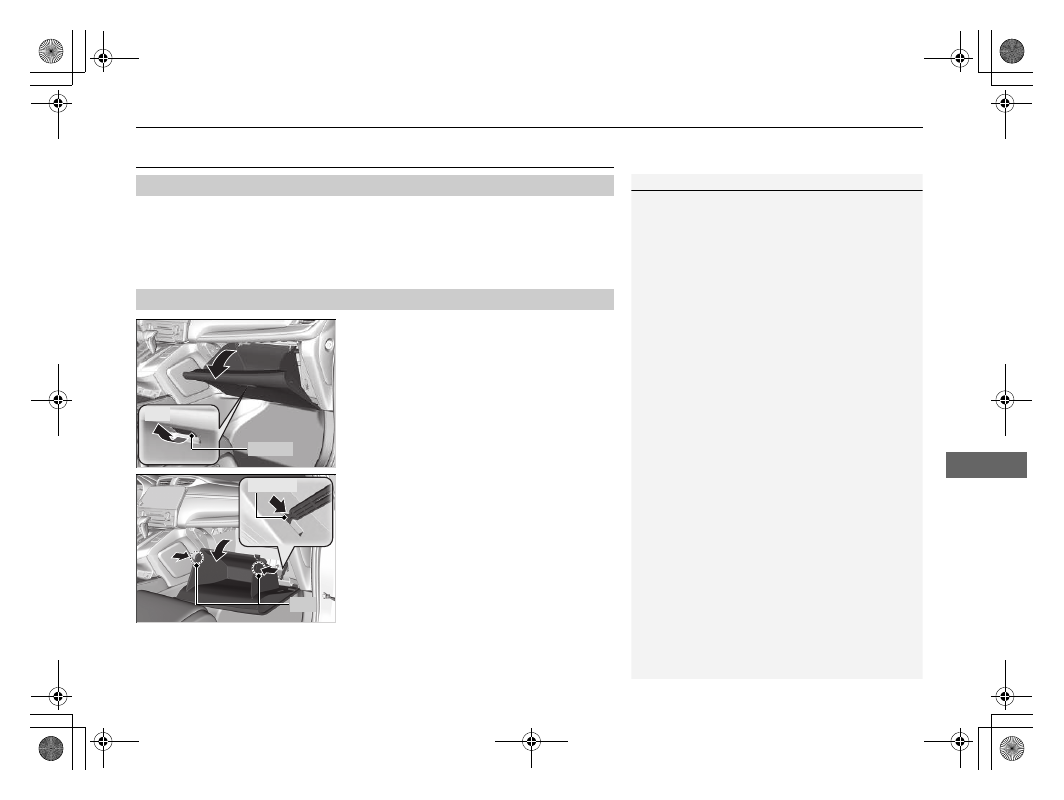
719
uu
Climate Control System Maintenance
u
Dust and Pollen Filter
Continued
Main
tenan
ce
Dust and Pollen Filter
Replace the dust and pollen filter according to your vehicle’s recommended
maintenance schedule. It is recommended to replace the filter even sooner if the
vehicle has been driven in a dusty environment.
2
1.
Open the glove box.
2.
Disengage the two tabs by pushing on each
side panel, then push down the stopper.
3.
Pivot the glove box out of the way.
■
When to Replace the Dust and Pollen Filter
■
How to Replace the Dust and Pollen Filter
1
If the airflow from the climate control system
deteriorates noticeably, and the windows fog up
easily, the filter may need to be replaced.
The dust and pollen filter collects pollen, dust, and
other debris in the air.
If you are not sure how to replace the dust and pollen
filter, have it replaced by a dealer.
Handle
Pull
Tab
Stopper
* Not available on all models

720
uu
Climate Control System Maintenance
u
Dust and Pollen Filter
Main
tenan
ce
4.
Push in the tabs on the corners of the filter
case cover, and remove it.
5.
Remove the filter from the case.
6.
Install a new filter in the case.
u
Put the
AIR FLOW
arrow directed side
down.
Cover
Push
Push
Tab
Tab
Dust and Pollen Filter
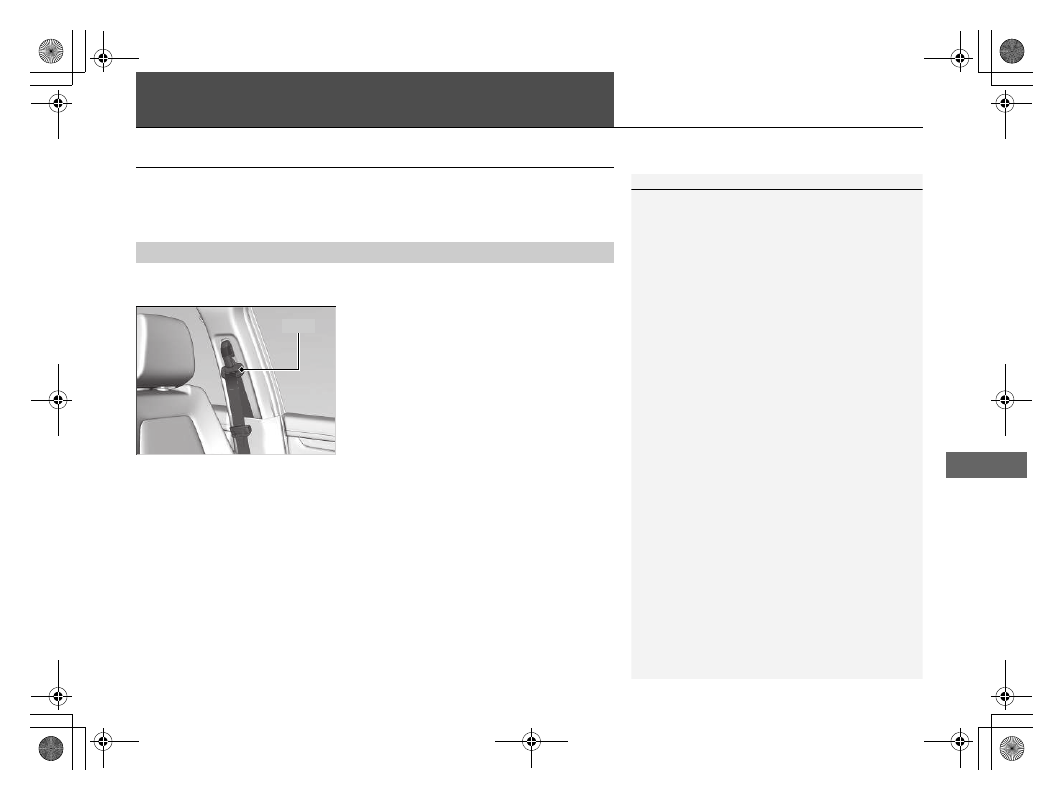
721
Continued
Main
tenan
ce
Cleaning
Interior Care
Use a vacuum cleaner to remove dust before using a cloth.
Use a damp cloth with a mixture of mild detergent and warm water to remove dirt.
Use a clean cloth to remove detergent residue.
Use a soft brush with a mixture of mild soap and warm water to clean the seat belts.
Let the belts air dry. Wipe the loops of the seat belt anchors using a clean cloth.
■
Cleaning Seat Belts
1
Do not spill liquids inside the vehicle. Electrical
devices and systems may malfunction if liquids are
splashed on them.
Do not use silicone based sprays on electrical devices
such as audio devices and switches. Doing so may
cause the items to malfunction or cause a fire inside
the vehicle.
If a silicone based spray is inadvertently used on
electrical devices, consult a dealer.
Depending on their composition, chemicals and
liquid aromatics may cause discolouration, wrinkles,
and cracking to resin-based parts and textiles.
Do not use alkali solvents or organic solvents such as
benzene or petrol.
After using chemicals, make sure to gently wipe them
away using a dry cloth.
Do not place used cloths on top of resin based parts
or textiles for long periods of time without washing.
Be careful not to spill a liquid type air freshener.
Loop
uu
Cleaning
u
Interior Care
722
Main
tenan
ce
Wipe using a glass cleaner.
To properly clean leather:
1.
Use a vacuum or soft dry cloth first to remove any dirt or dust.
2.
Clean the leather with a soft cloth dampened with a solution comprised of 90%
water and 10% neutral soap.
3.
Wipe away any soap residue with a clean damp cloth.
4.
Wipe away residual water and allow leather to air dry in the shade.
■
Cleaning the Window
■
Maintaining Genuine Leather
*
1
Wires are mounted to the inside of the rear window.
Wipe along the same direction as the wires with a
soft cloth so as not to damage them.
Be careful not to spill fluids, such as water or glass
cleaner, on or around the cover of both the front
sensor camera and the rainfall/light sensor
*
.
1
It is important to clean or wipe away dirt or dust as
soon as possible. Spills can soak into leather resulting
in stains. Dirt or dust can cause abrasions in the
leather. In addition, please note that some dark
coloured clothing can rub onto the leather seats
resulting in discolouration or stains.
* Not available on all models
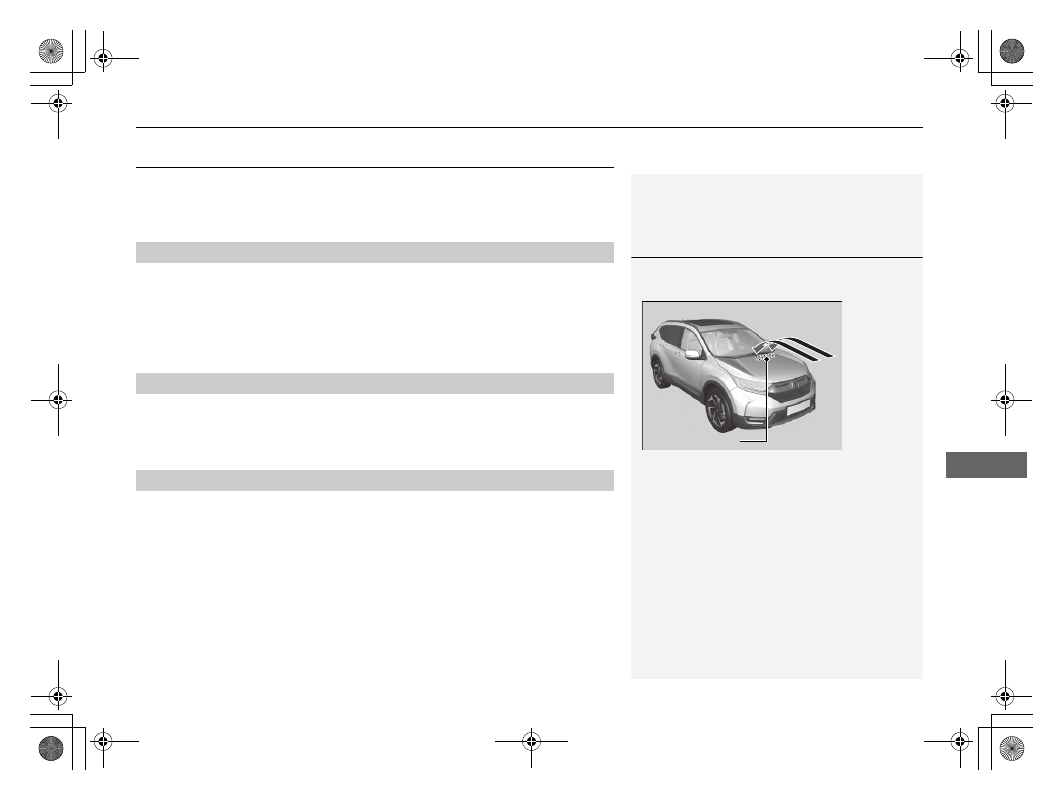
723
uu
Cleaning
u
Exterior Care
Continued
Main
tenan
ce
Exterior Care
Dust off the vehicle body after you drive. Regularly inspect your vehicle for scratches
on painted surfaces. A scratch on a painted surface can result in body rust. If you
find a scratch, promptly repair it.
Wash the vehicle regularly. Wash more frequently when driving in the following
conditions:
•
If driving on roads with road salt.
•
If driving in coastal areas.
•
If tar, soot, bird droppings, insects, or tree sap are stuck to painted surfaces.
•
Make sure to follow the instructions indicated on the automated car wash.
•
Fold in the door mirrors.
•
For models equipped with automatic intermittent wipers, turn the wipers off.
•
Keep sufficient distance between the cleaning nozzle and the vehicle body.
•
Take particular care around the windows. Standing too close may cause water to
enter the vehicle interior.
•
Do not spray high pressure water directly into the engine compartment. Instead,
use low pressure water and a mild detergent.
■
Washing the Vehicle
■
Using an Automated Car Wash
■
Using High Pressure Cleaners
1
Do not spray water into the air intake vents. It can
cause a malfunction.
If you need to lift the wiper arms away from the
windscreen, first set the wiper arms to the
maintenance position.
2
Changing the Front Wiper Blade Rubber
P. 700
Air Intake Vents
uu
Cleaning
u
Exterior Care
724
Main
tenan
ce
A good coat of automotive body wax helps to protect your vehicle’s paint from the
elements. Wax will wear off over time and expose your vehicle’s paint to the
elements, so reapply as necessary.
If you get petrol, oil, engine coolant, or battery fluid on resin coated parts, they may
be stained or the coating may peel. Promptly wipe it away using a soft cloth and
clean water.
Wipe using a glass cleaner.
■
Applying Wax
■
Maintaining the Bumpers and Other Resin Coated Parts
■
Cleaning the Window
1
NOTICE
Chemical solvents and strong cleaners can damage
the paint, metal, and plastic on your vehicle. Wipe
away spills immediately.
1
Maintaining the Bumpers and Other Resin Coated Parts
Ask a dealer about the correct coating material when
you want to repair the painted surface of the parts
made of resin.
725
uu
Cleaning
u
Exterior Care
Main
tenan
ce
Aluminium is susceptible to deterioration caused by salt and other road
contaminants. When necessary, as early as possible use a sponge and mild detergent
to wipe away these contaminants. Do not use a stiff brush or harsh chemicals
(including some commercial wheel cleaners). These can damage the protective finish
on aluminium alloy wheels, resulting in corrosion. Depending on the type of finish,
the wheels also may lose their lustre or appear burnished. To avoid water stains,
wipe the wheels dry with a cloth while they are still wet.
The inside lenses of exterior lights (headlights, brake lights, etc.) may fog temporarily
if you have driven in the rain, or after the vehicle has been run through a car wash.
Dew condensation also may build up inside the lenses when there is a significant
enough difference between the ambient and inside lens temperatures (similar to
vehicle windows fogging up in rainy conditions). These conditions are natural
processes, not structural design problems in the exterior lights.
Lens design characteristics may result in moisture developing on the light lens frame
surfaces. This also is not a malfunction.
However, if you see large amounts of water accumulation, or large water drops
building up inside the lenses, have your vehicle inspected by a dealer.
■
Maintaining Aluminium Wheels
■
Fogged Exterior Light Lenses
726
Main
tenan
ce
Accessories and Modifications
Accessories
When installing accessories, check the following:
•
Do not install accessories on the windscreen. They can obstruct your view and
delay your reaction to driving conditions.
•
Do not install any accessories over areas marked SRS Airbag, on the sides or backs
of the front seats, on front or side pillars, or near the side windows.
Accessories installed in these areas may interfere with proper operation of the
vehicle’s airbags or may be propelled into you or another occupant if the airbags
deploy.
•
Be sure electronic accessories do not overload electrical circuits or interfere with
proper operation of your vehicle.
2
•
Before installing any electronic accessory, have the installer contact a dealer for
assistance. If possible, have a dealer inspect the final installation.
1
When properly installed, mobile phones, alarms, two-
way radios, radio antennas, and low-powered audio
systems should not interfere with your vehicle’s
computer controlled systems, such as your airbags
and anti-lock brakes.
Honda Genuine accessories are recommended to
ensure proper operation on your vehicle.
3
WARNING
Improper accessories or modifications can
affect your vehicle’s handling, stability, and
performance, and cause a crash in which
you can be seriously hurt or killed.
Follow all instructions in this owner’s
manual regarding accessories and
modifications.
727
uu
Accessories and Modifications
u
Modifications
Main
tenan
ce
Modifications
Do not modify your vehicle in a manner that may affect its handling, stability, or
reliability, or install non-genuine Honda parts or accessories that may have a similar
effect.
Even minor modifications to vehicle systems can affect overall vehicle performance.
Always make sure all equipment is properly installed and maintained, and do not
make any modification to your vehicle or its systems that might cause your vehicle
to no longer meet your country’s and local regulations.
The on-board diagnostic port (OBD-II/SAE J1962 connector) installed on this vehicle
is intended to be used with automobile system diagnostic devices or with other
devices that Honda has approved. Use of any other type of device may adversely
affect the vehicle’s electronic systems or allow them to be compromised, possibly
resulting in a system malfunction, drained battery, or other unexpected problems.
Do not modify or attempt to repair any of the electrical components.
729
Handling the Unexpected
This chapter explains how to handle unexpected troubles.
Types of Tools . . . . . . . . .. 730
Changing a Flat Tyre . . . . . . 732
Checking the Engine . . . . . . 741
If the Keyless Remote Battery is Weak.. 742
Emergency Engine Stop . . . . ... 743
Models with keyless access system
Models with keyless access system
How to Handle Overheating. . . . 747
If the Low Oil Pressure Indicator Comes
On . . . . . . . . . . . . 749
If the Charging System Indicator Comes
On . . . . . . . . . . . . . 749
If the Malfunction Indicator Lamp Comes
On or Blinks . . . . . . . . ... 750
If the Brake System Indicator (Red) Comes
On or Blinks . . . . . . . . ... 751
If the Brake System Indicator (Red) Comes On
or Blinks at the Same Time When the Brake
System Indicator (Amber) Comes On..752
If the Electric Power Steering (EPS) System
Indicator Comes On . . . . . ... 753
If the Low Tyre Pressure/Deflation Warning
System Indicator Comes On or Blinks. . 754
If the Low Oil Level Symbol Appears. .755
Fuse Locations . . . . . . . . . 756
Inspecting and Changing Fuses. . 762
If You Cannot Open the Tailgate
* Not available on all models
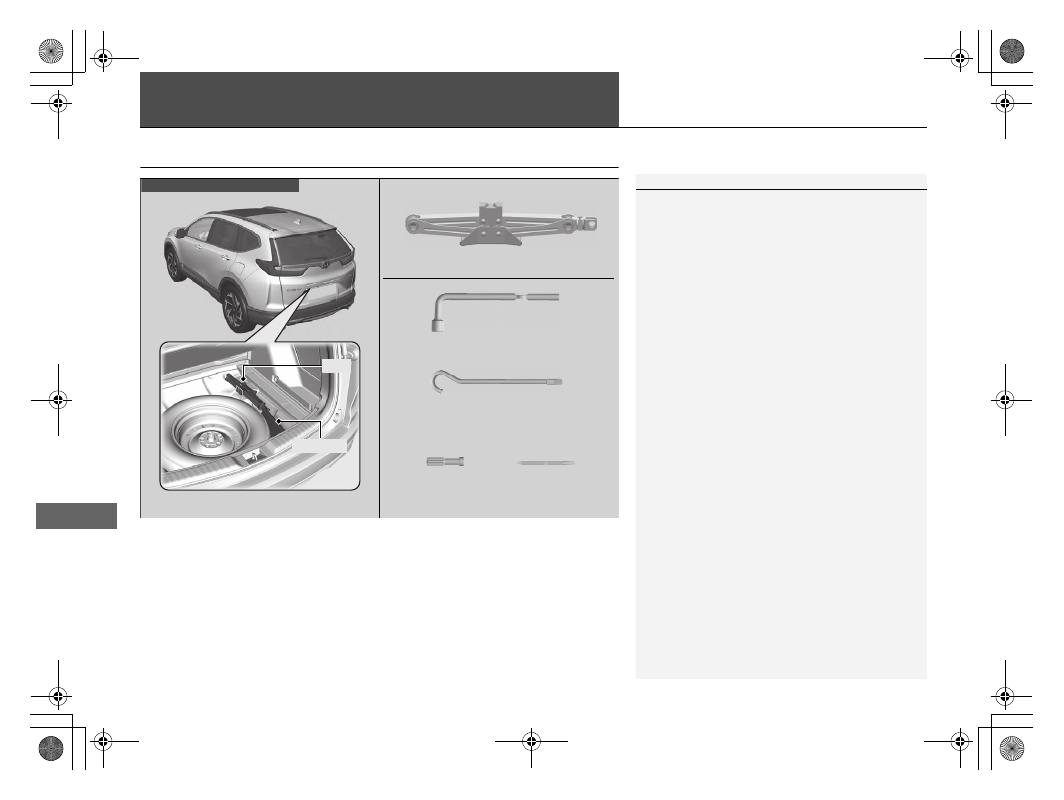
730
Han
d
lin
g the U
n
expected
Tools
Types of Tools
1
The tools are stored in the luggage area.
Jack
Jack Handle Bar
Wheel Nut Wrench/
Jack Handle
Jack
Screwdriver
Grip
Models without third row seat
Tool Bag

731
uu
Tools
u
Types of Tools
Han
d
lin
g the U
n
expected
Jack
Jack Handle Bar
Wheel Nut Wrench/
Jack Handle
Tool Case
Screwdriver
Grip
Models with third row seat
Jack
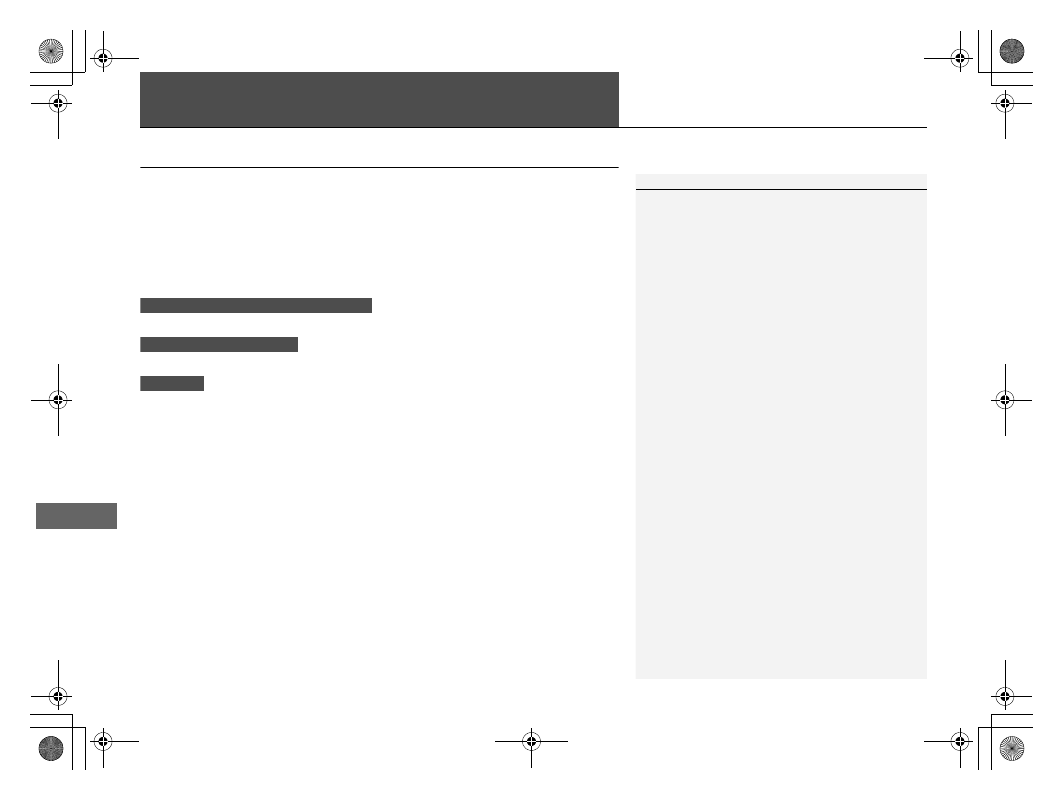
732
Han
d
lin
g the U
n
expected
If a Tyre Goes Flat
Changing a Flat Tyre
If a tyre goes flat while driving, grasp the steering wheel firmly, and brake gradually
to reduce speed. Then stop in a safe place. Replace the flat tyre with a compact
spare tyre. Go to a dealer as soon as possible to have the full-size tyre repaired or
replaced.
1.
Park the vehicle on a firm, level, non-slippery surface, and apply the parking
brake.
2.
Put the transmission into
(
P
.
2.
Put the transmission into
(
R
.
3.
Set the parking brake.
4.
Turn on the hazard warning lights and turn the ignition switch to LOCK
(
0
*1
.
*1: Models with the keyless access system have an
ENGINE START/STOP
button instead of an
ignition switch.
1
Follow compact spare precautions:
Periodically check the tyre pressure of the compact
spare. It should be set to the specified pressure.
Specified Pressure: 420 kPa (4.2 bar, 60 psi)
When driving with the compact spare tyre, keep the
vehicle speed under 80 km/h (50 mph). Replace with
a full-size tyre as soon as possible.
The compact spare tyre and wheel in your vehicle are
specifically for this model. Do not use them with
another vehicle. Do not use another type of compact
spare tyre or wheel with your vehicle.
Do not mount tyre chains on a compact spare tyre.
If a chain-mounted front tyre goes flat, remove one
of the full-size rear tyres and replace it with the
compact spare tyre. Remove the flat front tyre and
replace it with the full-size tyre that was removed
from the rear.
Mount the tyre chains on the front tyre.
A compact spare tyre gives a harsher ride and less
traction on some road surfaces. Use greater caution
while driving.
Do not use more than one compact spare tyre at the
same time.
The compact spare tyre is smaller than the regular
tyre. Your vehicle’s ground clearance reduces when
the compact spare tyre is installed. Driving over road
debris or bumps could possibly damage the
underside of your vehicle.
Continuously variable transmission models
Manual transmission models
All models
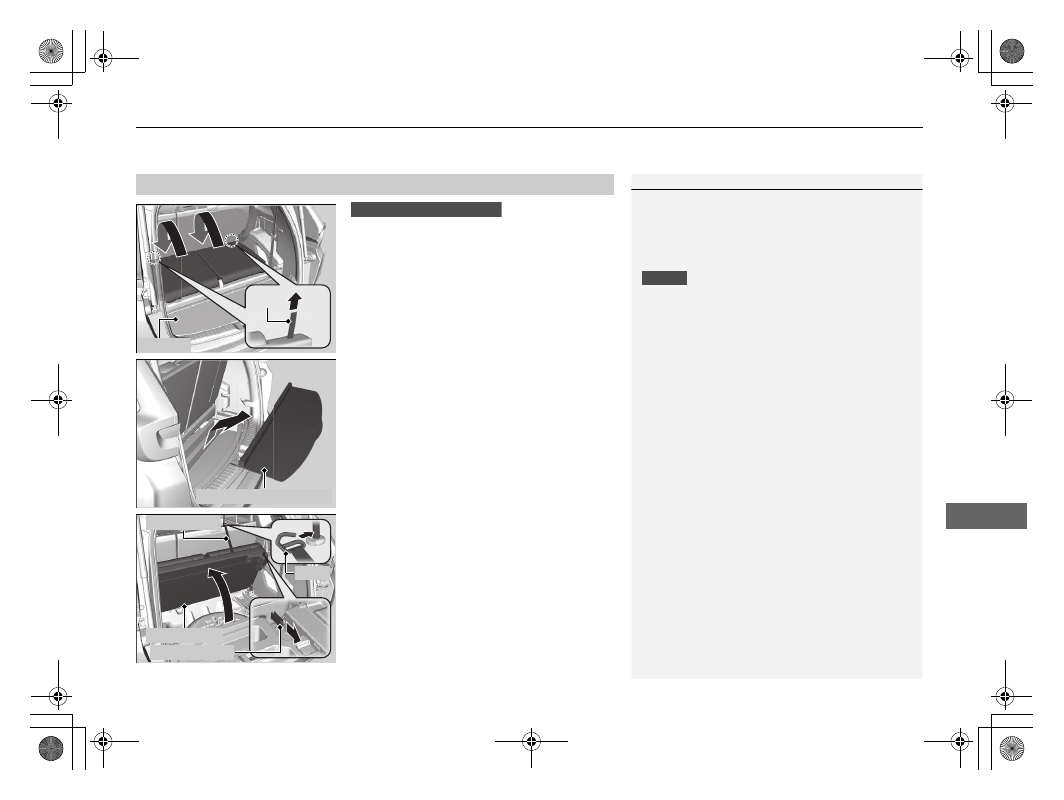
Continued
733
uu
If a Tyre Goes Flat
u
Changing a Flat Tyre
Han
d
lin
g the U
n
expected
1.
Lower the third row seat head restraint to
its lowest position.
Unlock the seat-back by pulling the strap.
Push the seat-back forward.
2.
Remove the floor lid.
3.
Remove the luggage area floor lid.
4.
Unlock the seat cushion by pulling the strap
(Yellow).
Push the seat cushion forward, then hook
the strap (Black) to the head restraint.
■
Getting Ready to Replace the Flat Tyre
1
WARNING:
The jack can only be used for helping an
emergency vehicle breakdown, not for changing the
regular seasonal tyre or any other normal
maintenance or repair operation.
NOTICE
Do not use the jack if it doesn’t work properly. Call
your dealer or a professional towing service.
Do not use the compact spare tyre if you are towing
a trailer.
Make sure all items in the luggage area or items
extending to the third row seats are properly secured.
Loose items can fly forward if you have to brake hard.
Strap
Floor Lid
Models with third row seat
Luggage Area Floor Lid
Strap (Yellow)
Strap (Black)
Seat Cushion
Hook
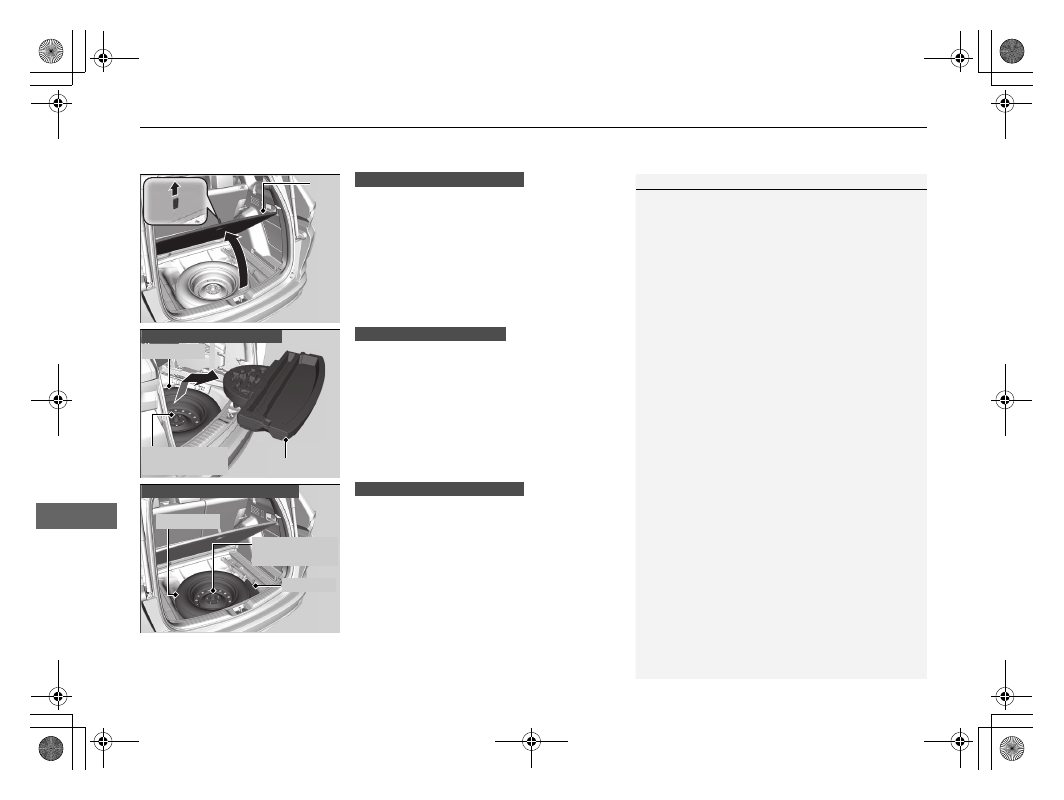
uu
If a Tyre Goes Flat
u
Changing a Flat Tyre
734
Han
d
lin
g the U
n
expected
5.
Open the luggage area floor lid.
6.
Take the tool case out of the luggage area.
Take the wheel nut wrench and jack handle
bar out of the tool case.
6.
Take the tool bag out of the luggage area.
Take the wheel nut wrench and jack handle
bar out of the tool bag.
1
Getting Ready to Replace the Flat Tyre
Be careful not to hurt yourself when removing or
storing the spare tyre.
Lid
Models without third row seat
Models with third row seat
Tool Case
Spare Tyre
Wing Bolt and
Spacer Cone
Models with third row seat
Tool Bag
Spare Tyre
Models without third row seat
Wing Bolt and
Spacer Cone
Models without third row seat
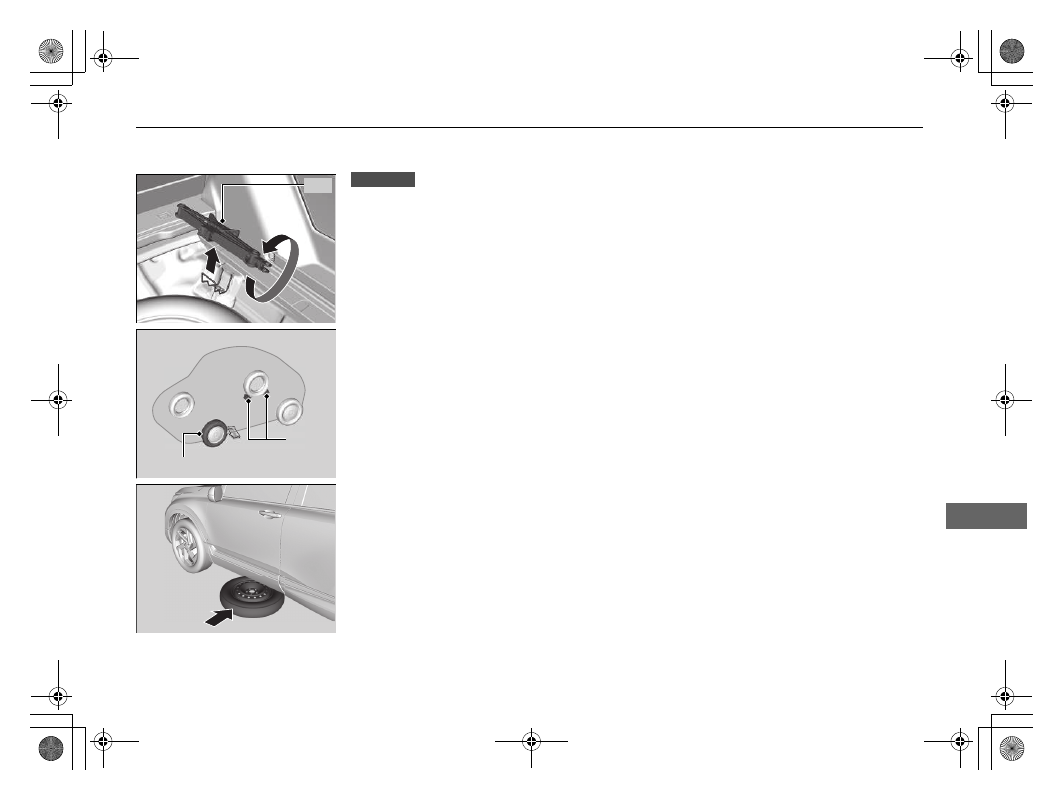
735
uu
If a Tyre Goes Flat
u
Changing a Flat Tyre
Continued
Han
d
lin
g the U
n
expected
7.
Take the jack out of the spare tyre area.
8.
Unscrew the wing bolt, and remove the
spacer cone. Then, remove the spare tyre.
9.
Place a wheel block or rock in front and rear
of the wheel diagonal to the flat tyre.
10.
Place the compact spare tyre (wheel side
up) under the vehicle body, near the tyre
that needs to be replaced.
Jack
All models
Wheel
Blocks
The tyre to be replaced.

Нет комментариевНе стесняйтесь поделиться с нами вашим ценным мнением.
Текст